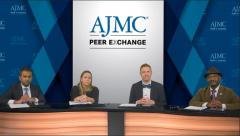
Clinical Collaboration Driving MM Treatment Pathways
Omar Nadeem, MD, shares perspective on the significance of collaborative care in the MM treatment landscape.
Episodes in this series

Ryan Haumschild, PharmD, MS, MBA: Dr Nadeem, as someone who does internal pathways and develops it well, tell us who’s in your disease state working group. Clinical pharmacy specialists, hematologists in the community, subspecialists, the medical director? Who’s involved in that discussion?
Omar Nadeem, MD: We have a big internal team that maintains the pathways. That includes pharmacists and several faculty members who are routinely reviewing the data and have a plan for what may be implemented and what changes may be coming in the next quarter or 6 months. An important point raised earlier is giving everybody who treats myeloma a seat at the table when it comes to incorporating changes into the pathway. Internally, we do the homework and get all the data. What are the recent approvals? Teclistamab, for example, was just approved a few weeks ago. How are we going to now incorporate that into the pathway? We gather the cost data, how [the agent] is infused, the premedications—the whole regimen essentially gets reviewed. Then we bring it to our review meeting, which involves all the stakeholders. Any centers that have signed up for our pathways get a seat at the table. We’re all in the same meeting, we review the data together, which get presented at that time.
We also review some of the points raised earlier about compliance to pathways and the common off-pathway regimens. Why are they off-pathway? Should we be looking at whether the same thing keeps happening quarter after quarter? Maybe there’s something our pathway needs to improve upon. This is a meeting that we have regularly to review that and make some of the changes. Then there’s a vote: should we incorporate these new data into the pathways, should we defer it pending other data, or should we reject it? It’s joint decision-making, and it gets implemented into the pathway. That’s a system we’ve created to make sure everybody gets a voice that’s using our pathways.
Ryan Haumschild, PharmD, MS, MBA: Dr Lipe, you talked about this utilizing community practice vs academics. At your organization [the University of Rochester], how are pathways utilized across the satellite locations and the main campus? Do you think they’re individualized enough, or is there some flex to make it patient specific?
Brea Lipe, MD: The commercial pathways that our university has are used for community sites in myeloma. At the academic center we have our own internal process for how we treat patients. It’s allowed us to be flexible and to modify things that we feel are important. Anyone is invited to those. We have different mechanisms from the academic center to the community center, at least in my institution. One of the things that allows us to reach out to our community partners is the ability to incorporate our clinical trials. That’s been a key thing.
Patients in the community who might not want to travel are able to know of these trial options because we can build them into the pathway. Everyone can see them. Maybe they didn’t think they wanted to travel, but this trial is motivation for them to come and learn about it. It’s allowed us to reach out to community providers in a different way, without inundating them [with questions].… Can you send me patients? It’s in real time for them. The ability to flex among those community sites is pretty limited, but it's driven by providers there. Some institutions are more comfortable with a certain drug than another drug. We often serve as a guideline in terms of how we use some of these drugs. A lot of times we end up modeling it. That’s how it works where we are.
Ryan Haumschild, PharmD, MS, MBA: I like how you incorporate clinical trials. You’re right: even if a patient is in the community, they still should be eligible for the trial. They need to find out if it’s the best for them. Incorporating that within your pathway is a great way to drive the best practice and the continued dedication to research. Thanks for sharing that. That was really helpful.
Transcript edited for clarity.
Newsletter
Stay ahead of policy, cost, and value—subscribe to AJMC for expert insights at the intersection of clinical care and health economics.






























































